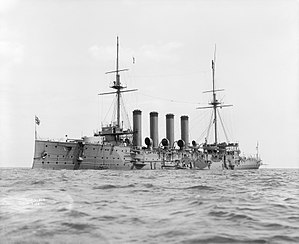HMS Hogue (1900)
 Hogue at anchor
| |
| History | |
|---|---|
| Name | HMS Hogue |
| Namesake | Battle of La Hogue |
| Builder | Vickers, Sons & Maxim, Barrow-in-Furness |
| Laid down | 14 July 1898 |
| Launched | 13 August 1900 |
| Completed | October 1902 |
| Commissioned | 19 November 1902 |
| Fate | Sunk by U-9, 22 September 1914 |
| General characteristics | |
| Class and type | armoured cruiser |
| Displacement | 12,000 long tons (12,000 t) (normal) |
| Length | 472 ft (143.9 m) (o/a) |
| Beam | 69 ft 6 in (21.2 m) |
| Draught | 26 ft 9 in (8.2 m) (maximum) |
| Installed power |
|
| Propulsion |
|
| Speed | 21 knots (39 km/h; 24 mph) |
| Complement | 725–760 |
| Armament |
|
| Armour | |
HMS Hogue was a
Design and description
Hogue was designed to
Her main armament consisted of two
The ship's waterline armour belt had a maximum thickness of 6 inches (152 mm) and was closed off by 5-inch (127 mm) transverse bulkheads. The armour of the gun turrets and their barbettes was 6 inches thick while the casemate armour was 5 inches thick. The protective deck armour ranged in thickness from 1–3 inches (25–76 mm) and the conning tower was protected by 12 inches (305 mm) of armour.[4]
Construction and service

Hogue, named after the 1692
Two years later Hogue became the boys' training ship for the
The squadron was tasked with patrolling the Broad Fourteens of the North Sea in support of a force of destroyers and submarines based at Harwich which protected the eastern end of the English Channel from German warships attempting to attack the supply route between England and France. During the Battle of Heligoland Bight on 28 August, the ship was part of Cruiser Force 'C', in reserve off the Dutch coast, and saw no action.[14] Hogue did, however, tow the heavily damaged light cruiser Arethusa, flagship of the commander of the Harwich Force, Commodore Reginald Tyrwhitt, back to port after the battle was over.[15]
Fate

On the morning of 22 September, Hogue and her sisters,

U-9, commanded by

Cressy attempted to ram the submarine, but did not hit anything and resumed her rescue efforts until she too was torpedoed at 07:20. She too took on a heavy list and then capsized before sinking at 07:55. Several Dutch ships began rescuing survivors at 08:30 and were joined by British fishing trawlers before Tyrwhitt and his ships arrived at 10:45. The combined total from all three ships was 837 men rescued and 62 officers and 1,397 ratings lost.[18] Hogue lost 377 men.[19]
In 1954 the British government sold the salvage rights to all three ships to a German company and they were subsequently sold again to a Dutch salvage company which began salvaging the wrecks' metal in 2011.[20][21]
Notes
- ^ "Cwt" is the abbreviation for hundredweight, 12 cwt referring to the weight of the gun.
Footnotes
- ^ Friedman 2012, pp. 335–36
- ^ Chesneau & Kolesnik, p. 69
- ^ a b Friedman 2012, p. 336
- ^ a b c Chesneau & Kolesnik, p. 68
- ^ Friedman 2011, pp. 71–72
- ^ Friedman 2012, pp. 243, 260–61
- ^ Friedman 2011, pp. 80–81
- ^ Friedman 2012, pp. 243, 336
- ^ a b Silverstone, p. 239
- ^ "Naval & Military Intelligence". The Times. No. 36561. London. 16 September 1901. p. 8.
- ^ "Naval & Military intelligence". The Times. No. 36629. London. 4 December 1901. p. 10.
- ^ "Naval & Military intelligence". The Times. No. 36930. London. 20 November 1902. p. 10.
- ^ Friedman 2012, p. 241; Silverstone, p. 239
- ^ Corbett, pp. 100, 171–72
- ^ Osborne, p. 104
- ^ Corbett, pp. 172–175
- ^ Massie, pp. 133–135
- ^ Massie, p. 135
- ^ The Dreadnought Project: H.M.S. Hogue (1900).
- ^ "Booty Trawl". Private Eye (1302). Pressdram: 31. 2011.(subscription required)
- ^ Ambrogi, Stefano (12 October 2011). "Scrap metal hunt is wrecking UK warship graves - veterans". Reuters. Thomson Reuters. Retrieved 20 February 2014.
Bibliography
- Chesneau, Roger & Kolesnik, Eugene M., eds. (1979). Conway's All the World's Fighting Ships 1860–1905. Greenwich, UK: Conway Maritime Press. ISBN 0-8317-0302-4.
- ISBN 0-89839-256-X.
- Firme, Tim; Johnson, Harold & MacDonald, Kevin C. (2005). "Question 27/04: British WW I Armored Cruiser Wrecks". Warship International. XLII (3): 242. ISSN 0043-0374.
- Friedman, Norman (2012). British Cruisers of the Victorian Era. Barnsley, South Yorkshire, UK: Seaforth. ISBN 978-1-59114-068-9.
- Friedman, Norman (2011). Naval Weapons of World War One. Barnsley, South Yorkshire, UK: Seaforth. ISBN 978-1-84832-100-7.
- ISBN 0-224-04092-8.
- Osborne, Eric W. (2006). The Battle of Heligoland Bight. Bloomington, Indiana: Indiana University Press. ISBN 0-253-34742-4.
- Silverstone, Paul H. (1984). Directory of the World's Capital Ships. New York: Hippocrene Books. ISBN 0-88254-979-0.
External links
